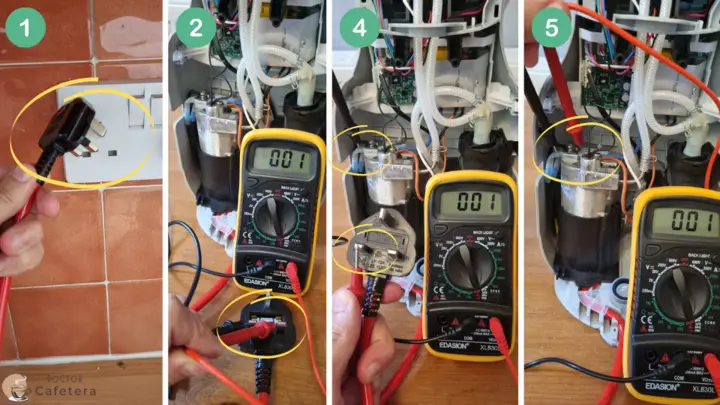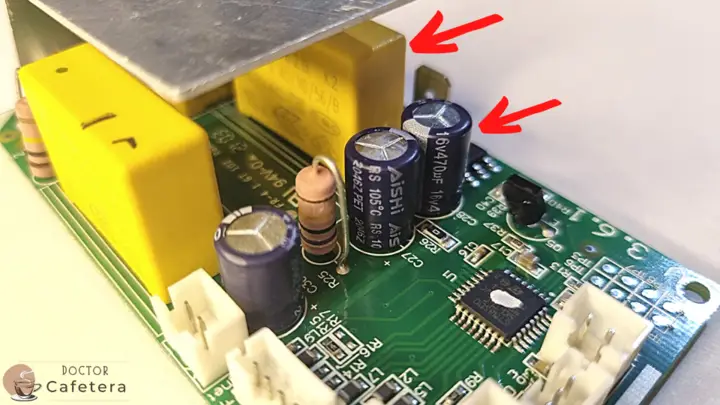Among the most robust and durable pod coffee makers on the market, we can find those of the Dolce Gusto brand. Their quality is quite high, but this does not exempt them from presenting a problem from time to time.
When we talk about a power failure, we refer specifically to coffee makers whose power button does not light up and does not produce any sound; basically, the coffee maker is dead. However, we will also see the case of coffee makers that turn on slightly but turn off after a few seconds.
Note: Before continuing with this guide, we recommend you check if your coffee maker is still under warranty; if so, you will not need anything more than contacting Dolce Gusto to order a new one. The Delonghi and Krups brands offer a two-year warranty for their Dolce Gusto pod coffee makers.
Reasons why a Dolce Gusto machine does not turn on
The main reason why the coffee maker does not turn on will be that its control board will not receive power, being this part is the “brain” of the machine. It could also be the case that the control board is defective, but this will be discussed later.
The control board is responsible for starting components such as the water pump, the thermoblock, the power button, etc. We are not saying that the coffee maker is defective, but the control board has no power supply.
Of course, there is a way to check if the control board is being powered. Pay close attention to the following:
- If your Dolce Gusto coffee maker does not turn on any light, the only component responsible is the control board.
- If your coffee maker manages to turn on the power button, then it means that the control board is still working.
- If your coffee maker does not turn on the power button but produces noise, it also means that the control board is working.
When our Dolce Gusto is completely “dead”, the control board does not receive any voltage, and we would have to find where the electric current has been interrupted in the circuit.
As for defective control boards, in my experience repairing Dolce Gusto coffee makers, I have seen boards affected by short circuits with damaged microprocessors and broken capacitors. So the control board can receive voltage but be damaged, and the coffee maker will not turn on.
Steps to find the point where the power supply is interrupted
Before starting, you must have a multimeter handy that allows you to measure the continuity (most have this option); with it, we will find the place where the circuit is open. Now follow these steps to find the point where the power is interrupted:
- Turn off and unplug the coffee maker (for no reason are you going to plug it in a while performing this process).
- Start by checking that the plug of your coffee maker is working correctly. You can do this by plugging it into any other appliance to check it.
- If a fuse protects your coffee maker’s cable, verify that there is continuity in the fuse by touching both ends with the multimeter until it beeps.
- Proceed to disassemble the coffee maker to have all the internal components visible.
- Now verify that there is no damage to the inside of the power cable. With the multimeter, touch the cable’s pins and the entrance of the thermoblock.
- Also, check for continuity in the thermal fuses located on the thermoblock. It is very common for these fuses to be damaged.
The most common situation is that one of the two fuses above the thermoblock has blown, and you have to replace it with a new one. The fuses pictured above (5) are SF129 10Amps 250V 133°C and are available on Amazon for about $6 for three pieces.
If you are replacing the fuses, follow these steps:
- Disassemble the coffee maker.
- Remove the screw that anchors the fuses to the thermoblock.
- Remove the plastic cover.
- Cut the fuse at the ends and solder a new one. Don’t be afraid to do it; it is easier than it looks, or ask someone to do it for you.
The control board of my Dolce Gusto machine is defective
If you have already ruled out that the continuity of the circuit is working correctly, the problem is directly on the control board. The thermal fuses, as we have already mentioned, are responsible for protecting the coffee maker in most cases, but sometimes the control board can break due to wear and tear caused by the many uses of the machine.
Capacitors are the most sensitive components of the control board and tend to lose their power over time. It is usually rare for a capacitor to break overnight. Normally, the coffee maker gradually loses power, decreasing water pressure and even causing the light on the power button to turn off.
If you are interested in measuring capacitance in capacitors, check out this article.
When this problem occurs with the control board, it is advisable to replace it with a new one or a second-hand one in good condition by buying an old coffee maker.
Conclusion
You already know that the problem is directly in the control board if your coffee maker does not turn on. And if it turns on, but after a few seconds, it shuts off or loses power, there is a problem with the capacitors on the control board.
If, when checking the continuity, you notice that the circuit breaks before reaching the control board, it is most likely that there is a problem with the thermal fuses, but you can easily replace them.

